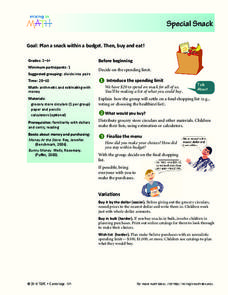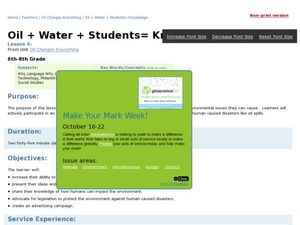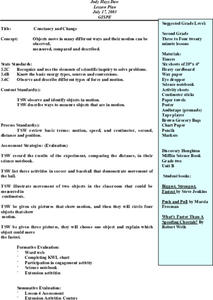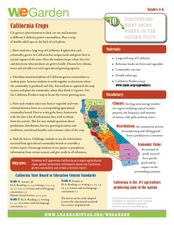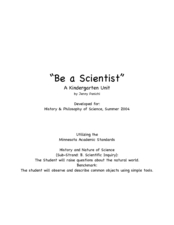Curated OER
Moving Out
Learners determine their cost of living. In this determining their cost of living instructional activity, students think of ten necessary things they would need if they moved out of their parents house. Learners research the...
Curated OER
Grand Grocery Graphs
Students experience creating their own graphs on graph paper and the computer program "Graph Club." They approach this task by utilizing food as their primary source for the activities. In addition, they interact with their peers as they...
Curated OER
Alphabet Shopping
The act of making up a grocery shopping list can have a lot of learning built into it. Kids love to do "grown-up" tasks, and this simple instructional activity allows them to do just that. Learners make up a shopping list by combining...
Curated OER
Special Snack
Students explore grocery store circulars to choose items for a snack. In this snack math lesson, students must plan a class snack for $20.00. Students create a list estimating costs. Students view lists and choose one for...
Curated OER
Shopping
Students demonstrate how to count money through a simulated shopping experience. In this consumer math instructional activity, students read the book Just Shopping With Mom and count play money to illustrate how much the items in the...
Alabama Learning Exchange
Classification
Students examine why scientists classify living organisms. They list and classify items they buy at the grocery store, sort and classify leaves, explore various websites, and write a biography of Carolus Linnaeus.
Curated OER
Shop 'Til You Drop
Students compare food prices to find the lowest unit price and make choices about where to shop and what to purchase on weekly items, cost comparisons and items needed. They collect grocery ads and weekly sale flyer's to expedite their...
Curated OER
Stopping Decay
Students review reasons why teeth are necessary, define tooth decay, discuss and list ways to prevent tooth decay, name at least two foods that promote dental health, watch video Tooth Wisdom, and complete worksheet Tooth Healthy Snacks.
Curated OER
Oil + Water + Students= Knowledge
Students create advertising with the intent of protecting wildlife. In this service learning lesson plan, students craft advertisements and write persuasive essays regarding the protection of wildlife.
Curated OER
Not Everything is More Expensive
Students compare prices and determine percent increases and decreases of items in order to make wise purchases. In this percent increases and decreases lesson plan, students calculate the amounts based on grocery store ads.
Curated OER
Party Time
Students engage in a lesson about finding information from the grocery store to put into data that can be measured. The data is found in advertisements and food labels. They plan the cost of a party when using the unit cost of various...
Curated OER
Health Education: Advertising
Fourth graders become conscientious consumers. In this personal health lesson plan, 4th graders analyze techniques used in advertising health-related products and services.
Curated OER
Constancy and Change
Second graders investigate how objects can move in different ways. They move in different ways across the room and develop a class list of movement words. Students also conduct a measuring motion experiment, create a bar graph for the...
Curated OER
Diversity of Trees
Fourth graders explore the uses of trees, In this trees lesson, 4th graders discover the uses of trees and how we use them everyday. Students collect items and decide if they are made from trees, have a scavenger hunt for wood products...
Curated OER
Origin of the Modern Olympic Games
Students using a Venn diagram, compare and contrast the modern and ancient Olympic games. They write essays and construct timelines about the games. Students, using various items, create tools for a new Olympic game and write the...
Curated OER
Origin of the Modern Summer Games
Young scholars discover the origin of the modern summer Olympic Games. In this history lesson, students compare and contrast the modern and ancient Olympic Games as they create a timeline.
Curated OER
California Crops
Young scholars explore agriculture by researching the native food crops of California. Students define a list of agriculture vocabulary terms and analyze maps of California which explain which foods come from which area. Young scholars...
Curated OER
How Pollution Disrupts Our Natural Environment
Students conduct experiments to illustrate global warming. For this air pollution lesson, students first examine how a layer of greenhouse gasses might impact the earth's atmospheric temperature, then evaluate how the layer of gasses...
Curated OER
Can You Measure Up!
Seventh graders investigate standards of measurement and metric units using a game to show the importance of standards of measurements. In this measuring lesson plan, 7th graders are grouped together and each group represents a foreign...
Curated OER
Make Slime
Students make slime. In this chemical reaction lesson plan, student use Borax to make a gel like solution. Students add all ingredients listed, add food coloring, and mix well. Students see first hand how chemicals react together...
Curated OER
Be a Scientist: A Kindergarten Unit
Students conduct observations using their five senses. In this science lesson, students describe different states of matter. They investigate the factors affecting mold growth.
Curated OER
Molehill or Mountain
Young scholars explore the concept of waste management. In this environmental stewardship lesson, students consider the trash generated by people per day and discuss what steps they can personally take to reduce waste.
Curated OER
Adding and Multiplying Decimals
Students review the process needed to add and multiply decimals. They work in pairs and use grocery store sale papers to plan a meal for 20 people. They multiply the price of the items to calculate a total cost.
Curated OER
Reading the River - Biological Classification
Youngsters create a list of grocery store items and then work together to categorize them as if they were setting up the shelves of the market. Then they are given a box of miscellaneous objects to practice categorizing. With these two...



